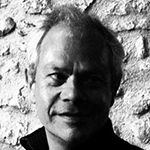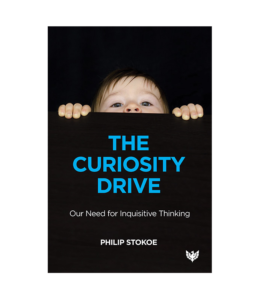
Philip Stokoe, BSc, MSc, CQSW, FInstPsychoanal is a psychoanalyst (Fellow of the Institute of Psychoanalysis) in private practice working with adults and couples, and an organisational consultant, providing consultation to a wide range of organisations since he qualified in 1983 at the Tavistock Centre. He has a particular interest in human creativity as it relates to the development of the mind and the central role of curiosity and interest. His early experience as an actor has left him with an abiding interest in theatre, art and cinema.
Here are his thoughts on the need for models in psychoanalytic work. Particularly in relation to the K-drive – the subject of his debut book: The Curiosity Drive: Our Need for Inquisitive Thinking
A colleague of mine said the other day that he wanted to listen to clinical material not theory. This was a perfectly reasonable comment in the circumstances, but it made me think. I realised that, for me, models of the mind, of how we function as individuals, as groups, in organisations, and as societies are essential to the work of understanding what’s going on at the moment. You could say that models are the articulation of beliefs. We know that when we are not conscious of our beliefs, they operate as facts; at least, not noticing them, we take them to be part of the fabric of life. When we can describe these beliefs, we immediately make them accessible to scientific enquiry. It becomes possible to test them against reality. This is the world of theory. The clear exposition and rigorous testing of our beliefs is the scientific approach.
The fact that psychoanalytic psychotherapists and organisational consultants share these theories, and the methods by which they test them, attests to the validity of the claim that psychoanalysis is a science. The problem is that many of us in the psychoanalytic professions fail to distinguish the part of psychoanalysis that is science from the rest of it. What I mean by the rest of it is the practice. There are a wide variety of applications of psychoanalysis in the form of different types of practice. Some psychoanalysts restrict the term “psychoanalysis” to the practice of analysing a patient 4–5 times a week and trying to understand how their unconscious mind is affecting the way that they perceive themselves and the world they live in. Others, including myself, see this as one example of the application of the science of psychoanalysis. Psychotherapy (less than 4 times a week) is another and so is the kind of organisational consultancy that comes out of the Tavistock school. These practices are not science, they are art. It is a rare thing to look back at the record of the session with a patient or the record of a meeting with the team and be able to say, that was completely right. It can take a lifetime to hone the skills involved in the practice of therapy or consultation, but it never reaches the point where, looking back at a session, you don’t think, oh, I could have said something else at that point.
This distinction has been useful for me in my attempts to understand different  approaches to writing (or teaching) about psychoanalysis. The theories of the development of the conscious mind that I write about in the book describe a process in which the thing we think of as ‘me’ comes into being. My understanding is that the accumulation of explanations as to ‘what is going on here’, stimulated by the curiosity drive (K-drive), actually forms the conscious mind. These explanations are in the form of images of ourselves in relation to others or parts of others, but they become increasingly complex as we acquire more understanding of our experience and they are refined by our learning from that experience as Bion observed. This is where science and art meet. You could say that those explanations are beliefs about the world and ourselves in it. The newly born infant has very few such explanations, which is why the earliest development of the mind is consistent across all cultures and civilizations up to the point of the discovery of what others and I have described as three dimensional psychic (or mental) space. By the time that puberty kicks in, the child has acquired so many beliefs, thoughts, experiences and explanations that his conscious mind is extremely complex. This creates a problem, which I shall try to describe.
approaches to writing (or teaching) about psychoanalysis. The theories of the development of the conscious mind that I write about in the book describe a process in which the thing we think of as ‘me’ comes into being. My understanding is that the accumulation of explanations as to ‘what is going on here’, stimulated by the curiosity drive (K-drive), actually forms the conscious mind. These explanations are in the form of images of ourselves in relation to others or parts of others, but they become increasingly complex as we acquire more understanding of our experience and they are refined by our learning from that experience as Bion observed. This is where science and art meet. You could say that those explanations are beliefs about the world and ourselves in it. The newly born infant has very few such explanations, which is why the earliest development of the mind is consistent across all cultures and civilizations up to the point of the discovery of what others and I have described as three dimensional psychic (or mental) space. By the time that puberty kicks in, the child has acquired so many beliefs, thoughts, experiences and explanations that his conscious mind is extremely complex. This creates a problem, which I shall try to describe.
It is clear that all other animals function perfectly well on the pleasure principle. We have to be able to explain why, for the massive majority of human beings, ‘the psychical apparatus had to decide to form a conception of the real circumstances in the external world and to endeavour to make a real alteration in them’ (Freud, 1911b). My claim is that the only way that we can explain the baby’s move from the pleasure principle to the reality principle or the paranoid–schizoid to the depressive position, is that there is this innate K-drive and that this does not exist in the same way in any other species. On the other hand, we would expect to see evidence that ‘curiosity’ is one of the psychic qualities in other animals, indeed it would be helpful if it seemed that the ‘higher mammals’ show an increase in curiosity-based behaviour over the less sophisticated species because this would suggest an evolutionary development.
The important thing is that the creation of the conscious mind depends upon the activation of the reality principle. The maintenance of the capacities that are developed by consciousness, for instance, symbolic function, complex thinking, development of memory to provide a sense of time and the concept of prediction, and others, depends upon the capacity to go on facing reality. We can see that this capacity is subject to considerable opposition; you don’t have to look only at yourself, we are faced with evidence of the avoidance of facing reality on a massive social scale in which all of us get involved. Climate change is the most dangerous but structural racism is another example, as is the terrifying way in which Trump has been able to remove the, often breathtaking, subtlety of politicians’ lies and boldly state complete nonsense in the certain knowledge that almost half of the population of the USA will accept it.
Let’s just pause for a moment to see this more clearly. Animals, particularly mammals, develop biologically in much the same way as humans do. The infant becomes a playful child, an awkward, sometime bolshy adolescent, a sexually driven adult and then old. It is easy to see the genetic predisposition, which is to reproduce the genes. Humans, on the other hand, demonstrate increasing confusion as development continues. We know that the biological imperatives are triggered in the same temporal order as in other mammals and yet humans respond to these physiological changes in very complex ways. It is clear that these complexities are the consequence of our having developed a conscious mind and, particularly, the characteristic that each of us believes this complex collection of beliefs and ideas is ‘me’. That means that the ordinary events of life, internal and external, are subject to revision by ‘me’. It cannot surprise us, therefore, that we become confused, dysfunctional, unhappy or disturbed. The art of helping us when we feel like this, is exemplified by psychoanalytically based therapy. It is not the only method; it is merely the one relevant to this essay.
At the point at which a psychotherapist is trying to help someone, they will be attempting to understand what beliefs and ideas are so distorting the patient’s view of themselves and the world they live in that they find themselves in sufficient trouble to seek help. This process, one that many psychoanalysts write about, is like a detective story. The danger that I want to alert us to today, is that one might feel, reading these detective stories, or a story about a collection of similar detective stories, that the writer actually believes that this is a description of what is going on in our minds all the time. As if every human being, from birth onwards, is engaged in an ontological, existential struggle to find and face the truth about life, the universe and everything. This clearly isn’t true. Just look around you. Most people successfully avoid such lines of thought entirely.
I was asked recently whether Freud thought there was a curiosity drive, and wasn’t that what he and Melanie Klein meant by the epistemophilic instinct. The simple answer is that neither of them saw this as an innate drive with the same status as Love and Hate; they both saw it as specific to sex or to exploring mother’s body. But that’s not the point. The really interesting thing about that question is why didn’t they see the fundamental importance of curiosity? I think it was because the most obvious thing about Freud, the thing that meant he was able to change his mind in the light of evidence, that meant he was able to see the things his culture and society didn’t want seen, all of this was the expression of his unshackled curiosity. He didn’t describe it as an innate drive because he lived it and exemplified it in all his writings. This is one of the curious effects of such a drive; it is as if we are fish, swimming in it, or it is the air that we breathe and, therefore, we do not notice it. Neither Freud nor Klein noticed the K-drive because they were energised by it. (I should add that this means that the apparent absence of curiosity, because it is the gateway to facing reality, has to be viewed as a serious symptom of psychic dysfunction.)
To return to sharing the experience of exploring someone else’s mind. By the time we are exploring the mind and the unconscious beliefs that interfere with a healthy balance of mind and body, we are in the world of the interaction between unconscious and conscious. It is a world in which we can never, in an unambiguous way, clearly describe; these are very complex processes. Those who describe these things best are poets and artists. The writings of psychoanalysts about the exploration of troubled minds is a form of poetry and it can only ever be the description of accompanying a patient in a waking dream.
In answering the question ‘Why do we need models?’, I find myself trying to distinguish between writing about the art and the science of psychoanalysis. Each version is an enquiry and an example of the K-drive in action, but the very fact that it is an expression of a drive means that we can lose our perspective on the nature of the particular enquiry we are engaged in. Both enquiries are carried out in that world in which conscious meets unconscious and we might notice patterns that appear often in work with different patients or clients. Those patterns might be the basis for models but there is a difference between a model that attempts to describe measurable and testable processes in the development of the mind or of thinking and relating, and one that describes the voyage within troubled minds, attempting to bring an understanding that can offer respite.
The former, if they are true, should be capable of clear and simple explanation and should make common sense. The latter are descriptions of detective journeys in realms that can never be described in simple terms. Great writing about the practice of psychoanalysis has the same quality of artistic brilliance. When such investigations are presented as if they show how the mind functions, it gives the impression that we are all constantly engaged in existential struggle. When they are presented as a record of detective journeys, they provide the best descriptions of how a psychoanalyst’s mind works and demonstrate true psychoanalytic practice. Both the art and the science depend upon each other, but it is important to be able to tell the difference.
Reference
Freud, S. (1911b). Formulation on the two principles of mental functioning. S. E., 7: 213–226.
Philip Stokoe

